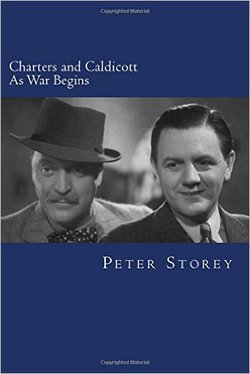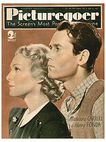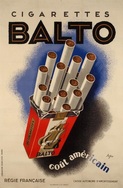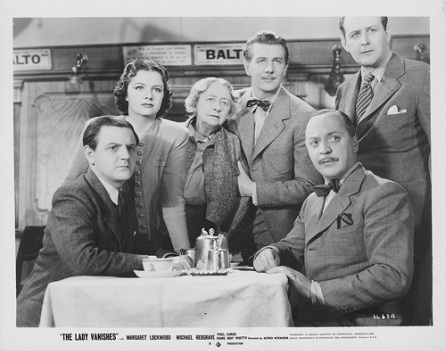The Lady Vanishes
|
The Lady Vanishes is a 1938 British comedy thriller film directed by Alfred Hitchcock. Charters and Caldicott are amongst passengers on a train out of the European country of Bandrika, delayed due to an avalanche. The last guests to book into an overcrowded inn theyend up sleeping in the maid's room. As the train departs, two other guests, Miss Froy and Iris befriend each other and share a compartment. As, Iris (played by Margaret Lockwood) wakes from a deep sleep she finds her friend has disappeared and her fellow passengers deny ever having seen the elderly lady. Iris is helped by a young musicologist, and the two proceed to search the train for clues to the old woman's disappearance. Eventually Miss Froy is found; Charters, Caldicott and the other English passengers all play a part in ensuring that Miss Froy safely returns to England. The Lady Vanishes is, for every reason, the very best of the very best. |
|
The Lady Vanishes was Hitchcock's penultimate British-made film before his move to the US. It was adapated from Ethel Lina White's novel The Wheel Spins. Charters and caldicott are the cricket-loving duo played by Naunton Wayne and Basil Radford and are the source of much of The Lady Vanishes' abundant humour
Charter and Caldicott quotes “It has always been my contention that the Hungarian Rhapsody is not their national anthem. “Blowing a gale? You don’t follow me sir, I’m enquiring about the test match in Manchester”. “My dear chap, you must have got hold of the wrong end of the stick somewhere” “Well after all, people don’t go around tying up nuns” “A nasty jam this, I don’t like the look of it”. “You heard what the Mother Superior said? If we surrender now we are in for it.” 
Charters and Caldicott - As War Begins Charters and Caldicott - As War Begins covers the period in Charters’ and Caldicott’s screen life between 1938 and 1943 covering their first four film appearances - The Lady Vanishes, Night Train To Munich, Crook’s Tour and Millions Like Us - all classic films. This book brings together - for the very first time - all the scenes that they appeared in - telling the story of what Charters and Caldicott saw, what they said and what they understood to be happening. It tells the humorous way that Charters and Caldicott saw the world and the funny and exciting adventures that happened to them during this very turbulent time in world history. To purchase the book, click on the link below https://www.amazon.co.uk/Charters-Caldicott-As-War-Begins/dp/151777876X/ref=sr_1_2?crid=3W3UU8LF7M8J6&dib=eyJ2IjoiMSJ9.7oeU2ozwVdIYpVHx0Vje62ehAO0WKO9vPQeM_CgzpPkgbfWL3JQ6YaqvJAauecTC.BLFGHgVX2NtW85S1QHBfl5sVsRj0hxHl-BJIGH0Z3pM&dib_tag=se&keywords=charters+and+caldicott&nsdOptOutParam=true&qid=1736790271&s=books&sprefix=charters+and+caldicott%2Cstripbooks%2C66&sr=1-2
The Lady Vanishes movie posters Posters from overseas Lobby Cards Artwork for DVD Covers Film Trivia  Picturegoer The Screen's Most Popular Magazine
Issue No 368, Vol 8, June 11, 1938. Picturegoer The Screen's Most Popular Magazine
Issue No 368, Vol 8, June 11, 1938.
The Lady Vanishes - What's in a name? In the gossip column of the June 1938 Edition of Picturegoer, all was revealed about how the name of the movie was selected. Hitchcock's movie was originally going to be called The Wheel Spins (this is the title of the novel that the movie is loosely based on). Then for reason or reasons unspecified, it became Lost Lady. And then, the Gainsborough studio tycoons consulted their studio employees by means of a ballot on the comparative suitability of three other titles of which they chose The Lady Vanishes. It is not clear what the other three title choices were. 
Brando Cigarettes smoked in The Lady Vanishes These French made cigarettes were seen being smoked during the train journey. The art deco poster advertising the brand is described as Cigarettes burst from the pack like New York skyscrapers in this dynamic poster for a French brand that boasts "American taste." The poster marks the mature style of Sepo, who opened his own studio in Paris that same year. He grew up and trained in Bologna, Italy, and then moved to Paris in 1920 where he worked in the Maga Agency along with Cappiello and Mauzan. In his own studio, Sepo's caricature-based style became more tightly constructed and geometric, strongly influenced by the Machine Age style of Cassandre. In Balto, we additionally see the influence of the rich color harmonies and luscious textures of Cassandre's partner, Charles Loupot. The result is a very stylish Art Deco design. Leading Lady Vivien Leigh originally tested for the role that eventually went to Margaret Lockwood. Film Set The film set that the movie was shot on was only ninety feet long in size Cricket Match The cricket match that is being talked about in the movie by Charters (Basil Radford) and Caldicott (Naunton Wayne) is the description of the actual third Ashes test between England and Australia at Manchester in 1938. The result of the test match quite rightly was shown in the end through a newspaper headline - "Match abandoned due to rain". The Journey Home The brief shot of a ferry bringing Iris and Gilbert back to England from across the English Channel from mainland Europe, also appears as an Irish Sea ferry in Will Hay's Oh, Mr. Porter!. Celebrity Fans Orson Welles reputedly watched this film eleven times at the time of its released.# Francois Truffaut claimed this film was his favorite Hitchcock and the best representation of Alfred Hitchcock's work. |
Film Frames
The Maid's Room!
Cricket Sir, Cricket!
The Dining Room
Bedtime in the Maid's Room
The train leaves Bandrika
The Lady Vanishes
The escape!
The Lady Vanishes Credits
Directed by Alfred Hitchcock Writing Credits Sidney Gilliat and Frank Launder ; Based upon the 1936 story: "The Wheel Spins" by Ethel Lina White Movie Production Company: Gainsborough Pictures Produced by Edward Black Cast
Caldicott Naunton Wayne Charters Basil Radford Iris Henderson Margaret Lockwood Gilbert Michael Redgrave Dr. Hartz Paul Lukas Miss Froy Dame May Whitty Mr. Todhunter Cecil Parker 'Mrs' Todhunter Linden Travers Baroness Mary Clare Hotel Manager Emile Boreo Blanche Googie Withers Julie Sally Stewart Signor Doppo (magician) Philip Leaver SignoraDoppo Selma Vaz Dias The Nun Catherine Lacey Madame Kummer Josephine Wilson The Officer Charles Oliver Anna Kathleen Tremaine Man in London Rail Station Alfred Hitchcock Violinist Roy Russell Foreign Officer Man Ernest Blyth Man at Station Alfred Hitchcock Room Service Waiter Arthur Hall Crew Screen play Frank Launder Screen play Sidney Gilliat Producer Edward Black (uncredited) Music by Louis Levy (uncredited) Charles Williams (uncredited) Cinematography Jack E. Cox (photography) Film Editing R.E. Dearing Set Decoration Alex Vetchinsky (settings) Assistant Director Roy Ward Baker (uncredited) Tom D. Connochie (uncredited) Art Department Maurice Carter Assistant Set Designer Albert Jullion Assistant Set Designer Albert Whitlock Scenic Artist (uncredited) Sound Sydney Wiles Recording Claude Hitchcock Sound assistant (uncredited) Camera Leslie Gilliat Camera operator (uncredited) Len Harris Camera assistant (uncredited) Leo Harris Assistant camera (uncredited) Maurice Oakley Location photographer (uncredited) Jack Parry Location photographer (uncredited) Editing Alfred Roome Cutting Music Louis Levy Musical director Cecil Milner Orchestrator (uncredited) Other crew Alma Reville Continuity
|


